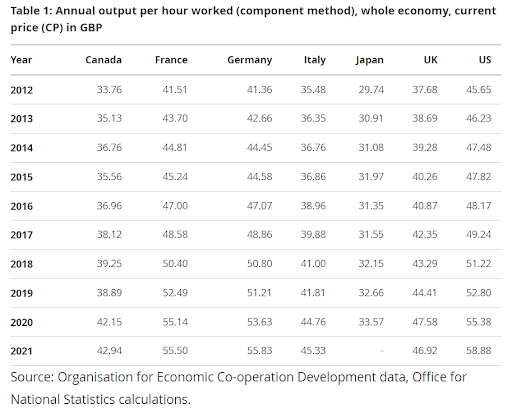Industrial Robotics in the UK
According to the IFR (International Federation of Robotics) the UK was number 24 globally (2021) in terms of the number of robots utilised against every 10,000 manufacturing workers yet, it is number 8 in terms of global manufacturing output (according to Make UK –2021 figures).
Robot density in the UK was reported at 101 units per 10,000 workers, below the average of 126 units globally and the lowest average within the G7 countries.
76% of new robot installation in 2021 were in 5 countries: China, Japan, USA, Korea and Germany and the UK accounted for only 0.4% new installations globally.
Clearly the UK lags the world in terms of robot utilisation. This could be the reason for the low UK productivity figures shown in the table below.

What does this mean for UK based manufacturing companies?
The world continues to operate more and more globally and we as manufacturers need to be, more than ever, globally competitive. The above figures show that there is room for the UK to make big improvements through the implementation and exploitation of robotics and automation.
What are the challenges to the adoption of industrial robotics for UK manufacturing businesses?
Understanding
As integrators what we always say to our customers is that we need to become experts in your processes, and you need to become experts in robotics. This is not simple for either party and requires time and dedication. The best jobs are those where both these needs are fully understood which can be either through a strong integrator / manufacturer relationship, where each party works with the other to develop the joint knowledge, or through the development of the necessary understanding internally thorough learning and education if you are working without an integrator.
If you are just starting to think about industrial robotics and automation, then it’s highly unlikely you understand robotics to the necessary level. We recommend reading our blog “How to understand and start using robot within your business.”
A common misconception about robots is that they are highly accurate. This is generally not true but of course it depends on your need, or level of accuracy. In Aerospace terms robots are quite inaccurate but in building or construction terms they can offer a reasonable level of accuracy.
Application
Choosing the right application to automate is critical, there are somethings that robots are excellent at and others that they are not good at.
Robots are great at carrying out dull repetitive tasks, they are not good at dealing with high levels of variation and where large amounts of dexterity is required. This said most operations can be automated these days but of course the cost will reflect this complexity.
General manufacturing tasks where robots have been proven time again are:
- Pick and place – Material handling.
- Welding
- Machine tending
- Painting
- Mechanical cutting, grinding polishing deburring.
- Loading and unloading
- Adhesive or sealant application
- Inspection measurement
Managing Automation within your business
When companies invest in automation for the first time there is usually a rapid learning curve that they need to go through especially in the first year. Companies that don’t put time and effort into learning the new necessary skills will probably have problems and may regret the investment in automation. At A3L we always recommend that someone who is keen to learn and expand their skillset take ownership of the robot and they become the focus for any problem solving, training or development within the business.
Training
With any purchase of a robot a company will probably receive some training in its use, application, and maintenance. At A3L we believe this is only the start of the journey and a company will have to use this training as a basis to develop their own skill set.
Cost
The cost of a robot is commonly offset against time, quality, efficiency and other savings that it brings to the table but is worth remembering that there will be a cost in terms of the above (generating the necessary knowledge). It also worth understanding that costing an automation job is very tricky.
Summary
There is a clear picture demonstrating that UK manufacturing is falling behind global competitors in terms of the utilisation of robotics and automation but this is also an opportunity as it demonstrates a clear route for improvement.
Related posts
Robot offline programming
What is offline programming? Robot offline programming (OLP) in essence is the programming of a robo
Belt Grinding Machine Automation
Belt grinding machine automation is used extensively in manufacturing for finishing operations or al
Automated Abrasive Finishing Systems
A3L specialise in delivering robotic and bespoke automated abrasive finishing systems into the UK an